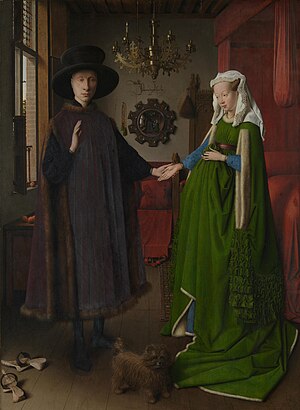All AP Art History Resources
Example Questions
Example Question #1 : Answering Other Questions About Fourteenth Through Sixteenth Century 2 D Art
Renaissance painting was different from medieval painting for all of the following reasons EXCEPT __________.
increased use of Christian imagery
preference of classical over religious themes
increased use of perspective
wider contrast between dark and light elements
increased use of Christian imagery
The Renaissance saw an explosion in new forms of art, which explicitly sought a break from Medieval tradition. One of the chief features thematically was a revival in Classical subjects from ancient Greece and Rome. Renaissance artists also used new techniques and methods to create wider use of perspective and contrast in colors and light elements.
Example Question #92 : Renaissance To Contemporary 2 D Art
Oil Paint only became widespread in European art in the __________.
late fourteenth century
early fifteenth century
late fifteenth century
early fourteenth century
late fifteenth century
Oil paint, created by blending paint pigments with flaxseed or linseed oil, allows for deeper and richer colors, which can also be blended more easily into different colors. Oil painting replaced tempera paint, which was mixed with egg yolk, in Europe around the late fifteenth century, initially in the work of Early Netherlandish painters, like Jan van Eyck. Van Eyck's influence on the Italian Renaissance made oil painting the standard in European art by 1500.
Example Question #2 : Answering Other Questions About Fourteenth Through Sixteenth Century 2 D Art
The sixteenth-century German artist who wrote an influential work on human proportion was __________.
Lucas Cranach the Younger
Hans Holbein the Younger
Matthias Grünewald
Albrecht Dürer
Albrecht Dürer
Albrecht Dürer was the most well-respected and influential German artist of the Early Renaissance period. A large portion of this influence stems from his impressive paintings and engravings; however, he also wrote two books of art theory, Four Books of Measurement and Four Books of Proportion, which were widely read by generations of artists.
Example Question #91 : Renaissance To Contemporary 2 D Art
Southern European nations are more likely to possess pre-Renaissance religious art because __________.
more Northern European nations became Protestant and therefore were more likely to destroy images of saints
the religious art made in Southern Europe was more likely to find favor with the Catholic Church
the weather in Southern Europe was more likely to preserve art over the centuries
more religious art was made in Southern Europe before the Renaissance
more Northern European nations became Protestant and therefore were more likely to destroy images of saints
In Europe, the Renaissance and the Protestant Reformation occurred essentially simultaneously, with a revolution in art taking place at the same time as an upheaval in religion. The religious turmoil often affected art made before the time period, however, because many Protestants were iconoclasts who sought to destroy all religious imagery, especially those of saints and other intermediaries.
Example Question #95 : Renaissance To Contemporary 2 D Art

Pictured above is the Arnolfini Portrait, and can be found at the Website of National Gallery, London.
The medium of the work is __________.
tempera
acrylic
fresco
oil
oil
As is common in the Northern Renaissance tradition, Van Eyck takes advantage of the slow drying time of oil to get the level of detail he achieves.
Example Question #96 : Renaissance To Contemporary 2 D Art

Pictured above is the Arnolfini Portrait, and can be found at the Website of National Gallery, London.
The image depicts a __________.
father and daughter
brother and sister
duke and dutchess
husband and wife
husband and wife
The figures are arranged in a standard pose of a newly-married couple, and the poses of each as well as the adornment on the woman's head suggest they are wed.
Example Question #7 : Answering Other Questions About Fourteenth Through Sixteenth Century 2 D Art

Pictured above is the Arnolfini Portrait, and can be found at the Website of National Gallery, London.
The house in which the couple resides is located in __________.
The Netherlands
Finland
England
France
The Netherlands
The painting is of Netherlandish Renaissance style and was painted by Jan van Eyck, who is from the Netherlands.
Example Question #92 : Renaissance To Contemporary 2 D Art

Pictured above is the Arnolfini Portrait, and can be found at the Website of National Gallery, London.
The work depicts all of the following except __________.
the power of the Christian church
the importance of status and tradition
the signature of the artist
the subservience of women in the fourteenth-century Netherlands
the power of the Christian church
Jan van Eyck signed his painting above the mirror. As well, the placement of the wife near the bed suggests submission to the power of the man, while the stiff pose and dress is tradition for the time. There is nothing religious, though, about the painting.
Example Question #98 : Renaissance To Contemporary 2 D Art

Pictured above is the Arnolfini Portrait, and can be found at the Website of National Gallery, London.
The painting reflects van Eyck's interest in __________.
the value of a clean and tidy household
the authority of the church
tradition and ceremony in his community
the dominance of women in European society
tradition and ceremony in his community
This painting represents a tradition of Netherlandish weddings, and it reflects the traditions of that society.
Example Question #3 : Answering Other Questions About Fourteenth Through Sixteenth Century 2 D Art

Pictured above is the Arnolfini Portrait, and can be found at the Website of National Gallery, London.
The painting's audience was likely __________.
the Christian church
the Arnolfini family
the artist
the local community
the Arnolfini family
The painting was commissioned by Giovanni Arnolfini for the purpose of private viewing in his house.
All AP Art History Resources




